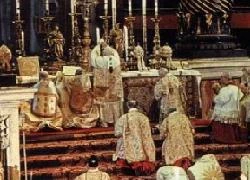Kansas Governor Corruption Scandal Update
Another Update: Gov. Sebelius claimed the private soirée held on April 9, 2007 with Dr. Tiller was “reimbursed by the Greater Kansas City Women’s Political Caucus.” It turns out it was indeed reimbursed—only ten days ago, well after the photos exposing her steak-and-lobster party with Tiller made national headlines.
 Original Post: Governor Sebelius is seen in this video defending her story that Dr. Tiller attended a Greater Kansas City Women’s Political Caucus Torch Dinner and bought the charity prize of an evening at her mansion. The only problem with this story is that receipts from the 2006 Torch Dinner (it couldn’t have been 2007, because that was held months after the private soirée at the Governor’s mansion) do not list Dr. George Tiller or his wife, nor his abortion clinics or affiliates as having bought anything. In addition, Gov. Sebelius claims the taxpayer-funded dinner at her mansion was a political event, and was therefore reimbursed by the GKC Women’s Political Caucus; there are no documented reiumbursements, however, from the Women’s Political Caucus to Kansas State in 2006 or 2007.
Original Post: Governor Sebelius is seen in this video defending her story that Dr. Tiller attended a Greater Kansas City Women’s Political Caucus Torch Dinner and bought the charity prize of an evening at her mansion. The only problem with this story is that receipts from the 2006 Torch Dinner (it couldn’t have been 2007, because that was held months after the private soirée at the Governor’s mansion) do not list Dr. George Tiller or his wife, nor his abortion clinics or affiliates as having bought anything. In addition, Gov. Sebelius claims the taxpayer-funded dinner at her mansion was a political event, and was therefore reimbursed by the GKC Women’s Political Caucus; there are no documented reiumbursements, however, from the Women’s Political Caucus to Kansas State in 2006 or 2007.
This is looking worse and worse for Governor Sebelius. If she is not outright lying, then at the very least she should have had the wisdom to tactfully turn down the charity auction prize Tiller won, knowing he was under criminal investigation and thus risking—as she has so done—the appearance of impropriety. But until the Governor can produce objective evidence to back up her claim that the private dinner was not held specifically in Tiller’s honor, her office is beginning to smell pretty rotten…
National Review has a good article summarizing the power and corruption of the abortion industry in Kansas, and how it has ruined at least one good man’s career, with the help of Gov. Sebelius.
"Once our office started looking into records surrounding this auction reception it was determined that the policy in place for reimbursement on political events was not followed due to staff turnover and the length of time between the purchase of the auction item (September, 2005) and the date the reception was scheduled (April, 2007)," reads the explanation from Sebelius' spokeswoman Nicole Corcoran.So far as they know, reimbursement has been timely received on all other taxpayer-funded events held at the mansion. Some wonder whether or not the governor’s explanation is entirely truthful, or just a fabricated cover story to save her reputation. The inside source that leaked the photos and was present at the party insists it was an invitation-only event held expressly to honor Dr. Tiller, and not a charity auction prize.
 Original Post: Governor Sebelius is seen in this video defending her story that Dr. Tiller attended a Greater Kansas City Women’s Political Caucus Torch Dinner and bought the charity prize of an evening at her mansion. The only problem with this story is that receipts from the 2006 Torch Dinner (it couldn’t have been 2007, because that was held months after the private soirée at the Governor’s mansion) do not list Dr. George Tiller or his wife, nor his abortion clinics or affiliates as having bought anything. In addition, Gov. Sebelius claims the taxpayer-funded dinner at her mansion was a political event, and was therefore reimbursed by the GKC Women’s Political Caucus; there are no documented reiumbursements, however, from the Women’s Political Caucus to Kansas State in 2006 or 2007.
Original Post: Governor Sebelius is seen in this video defending her story that Dr. Tiller attended a Greater Kansas City Women’s Political Caucus Torch Dinner and bought the charity prize of an evening at her mansion. The only problem with this story is that receipts from the 2006 Torch Dinner (it couldn’t have been 2007, because that was held months after the private soirée at the Governor’s mansion) do not list Dr. George Tiller or his wife, nor his abortion clinics or affiliates as having bought anything. In addition, Gov. Sebelius claims the taxpayer-funded dinner at her mansion was a political event, and was therefore reimbursed by the GKC Women’s Political Caucus; there are no documented reiumbursements, however, from the Women’s Political Caucus to Kansas State in 2006 or 2007. This is looking worse and worse for Governor Sebelius. If she is not outright lying, then at the very least she should have had the wisdom to tactfully turn down the charity auction prize Tiller won, knowing he was under criminal investigation and thus risking—as she has so done—the appearance of impropriety. But until the Governor can produce objective evidence to back up her claim that the private dinner was not held specifically in Tiller’s honor, her office is beginning to smell pretty rotten…
National Review has a good article summarizing the power and corruption of the abortion industry in Kansas, and how it has ruined at least one good man’s career, with the help of Gov. Sebelius.










 Legionary of Christ Father Edward McNamara, professor of liturgy at the Regina Apostolorum university, discusses some of the liturgical changes implemented by our Holy Father:
Legionary of Christ Father Edward McNamara, professor of liturgy at the Regina Apostolorum university, discusses some of the liturgical changes implemented by our Holy Father:










































